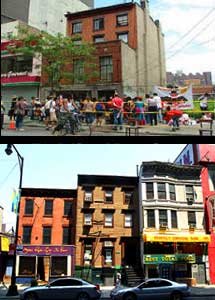
There is no question that Duffield Street was home to important Abolitionists. The NYC Economic Development Corporation (EDC) does not dispute this. The EDC thinks these homes should be replaced with a parking lot because there is not sufficient evidence at this time that the homes were part of the Underground Railroad.
This is not the first time in New York that anti-slavery homes were under threat. This week is the anniversary of the 1863 draft riots, one of the deadliest civil disturbances in the history of the United States.
There is a great summary of the riots at NY Draft Riots on the Virtual New York website. Here's an excerpt:
The article focuses on Manhattan, but it does show that some of the most important African-American communities have been in Brooklyn since the 18th century. Here is an excerpt from the Encyclopedia of New York African-American section:By analyzing who and what the rioters targeted for attack during the riot we can begin to understand the complicated social, economic, and political conflicts that divided New York City's citizens in July 1863.
The city's black citizens were perhaps the most obvious and visible targets of the rioters' wrath. By the end of the first day of rioting, It was not safe for African Americans to appear in public. Rioters beat individual black citizens and, in several instances, brutally murdered and mutilated African-American men. Black New Yorkers weren't even safe inside their homes as roaming bands of rioters attacked black neighborhoods. Not only were African Americans in danger; rioters also attacked white New Yorkers who provided shelter for endangered African Americans, sacking and burning the homes of white sympathizers.
In 1796 a group of free Africans in New York City began to hold meetings that eventually led to the formation of the African Methodist Episcopal Zion Church, the first black congregation in the city (eventually known as "Mother Zion," it later occupied a church built at Church and Leonard streets in 1801). The first black Baptist church in the city, the Abyssinian Baptist Church, was formed in 1808 on Worth Street and directed by Thomas Paul. In the same year the African Association for Mutual Relief, the first insurance company that catered to blacks, was opened on Baxter Street by several black civic and political leaders, including James Varick (first bishop of the African Methodist Episcopal Zion Church), the restaurateur Thomas Downing, Peter Williams Jr., John Teasman, and Henry Sipkins. African-American members of the White Sands Street Methodist Church in Brooklyn left in 1812 to form the High Street African Wesleyan Methodist Episcopal Church, and the first congregation of black Episcopalians, led by Williams, built St. Philip's Protestant Episcopal Church on Centre Street in 1818. Out of the early African-American churches grew literary and musical societies, church schools, and benevolent organizations such as the New York African Society for Mutual Relief (formed in 1808).You could say that the Civil War was about property rights versus human rights. But the EDC certainly is not on the side of property rights on Duffield Street- they want to confiscate property that is not theirs for dubious economic benefit.
In order to destroy property, New Yorkers used to resort to wild hooligans in the street. How old fashioned! Why, the EDC doesn't need to resort to such tactics, especially with friends like AKRF.
